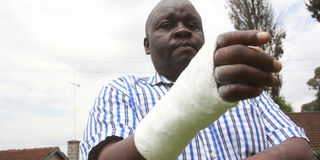First aid for dislocations

Danson Maina leaves Jamii Hospital in Karatina where he was treated after he dislocated his finger. A dislocation occurs when the bones are detached or dislocated from their normal position or sockets. PHOTO | JOSEPH KANYI |
What you need to know:
- A dislocation temporarily immobilises or deforms the joint, causing severe pain and swelling
- Generally, the symptoms include pain, difficulty in moving the injured joint, tenderness, discolouration, and swelling
They are a common form of injury especially among those who are active in sports.
A dislocation occurs when the bones are detached or dislocated from their normal position or sockets. This could be due to trauma from a fall, an accident, or during intensive activity or sports.
Normally it involves the large joints of the body such as the shoulder, ankle, knee, and elbow. The thumb is also vulnerable to dislocation.
A dislocation temporarily immobilises or deforms the joint, causing severe pain and swelling. Generally, the symptoms include pain, difficulty in moving the injured joint, tenderness, discolouration, and swelling.
TIPS OF HANDLING DISLOCATION
Here are a few tips on how to care for a person with a dislocation.
Immobilise: The first step is to ensure that the person does not move the joint. You should ensure that the dislocated joint remains
motionless.
Do not try to force it back to into position since this may cause more damage to the muscles, ligaments, blood vessels, or nerves around the affected region. Until medical care is available, splint the affected part in a fixed position.
Start by cutting away the clothing around the affected area. If this is not possible, remove the clothing without moving or hurting the injured part of the body.
In some instances, the dislocation may tear the skin. In such a case, clean and disinfect before bandaging.
Splint: Depending on the dislocated part, there are various ways to keep the dislocation immobile and safe. For example, in case of a shoulder dislocation, one can use a pillow or a sling to support the weight of the arm to ease strain on the injured shoulder.
If an arm or leg is dislocated, gently tape the area to a ruler, a rolled-up newspaper, or a rolled-up piece of cloth with a first aid tape.
Ice: Since a dislocated joint causes sudden and severe pain and swelling in the surrounding area, it is important to place ice on the injured joint - it helps to reduce pain, build-up of fluids, and internal bleeding around the joint.
Ice should not be placed directly on the skin, instead, wrap it in a cloth before placing on the affected area.
Pain Relieve: If the pain is severe, give ibuprofen or paracetamol. However, if the person has heart problems, diabetes, or hypertension, it is inadvisable to give medication without prescription by a doctor.
Remember that first aid is not a treatment option, rather, a way to prevent worsening of the injury as the patient awaits medical help.




